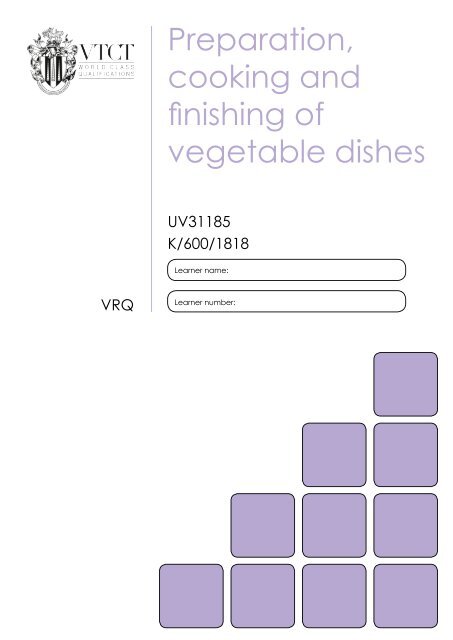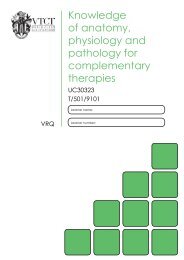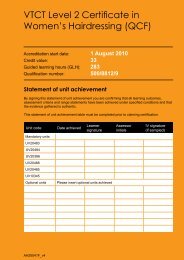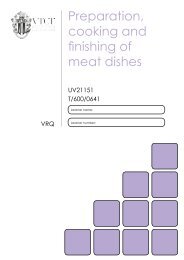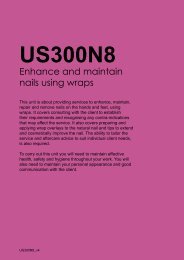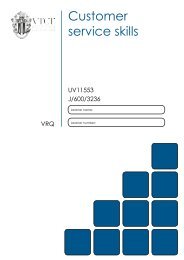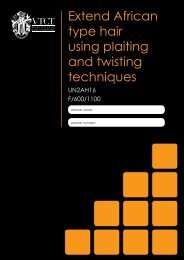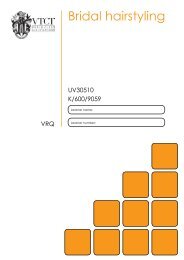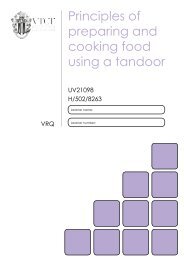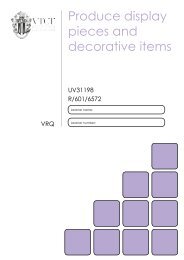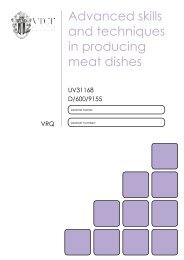Preparation, cooking and finishing of vegetable dishes - VTCT
Preparation, cooking and finishing of vegetable dishes - VTCT
Preparation, cooking and finishing of vegetable dishes - VTCT
You also want an ePaper? Increase the reach of your titles
YUMPU automatically turns print PDFs into web optimized ePapers that Google loves.
VRQ<br />
<strong>Preparation</strong>,<br />
<strong>cooking</strong> <strong>and</strong><br />
<strong>finishing</strong> <strong>of</strong><br />
<strong>vegetable</strong> <strong>dishes</strong><br />
UV31185<br />
K/600/1818<br />
Learner name:<br />
Learner number:
Statement <strong>of</strong> unit achievement<br />
By signing this statement <strong>of</strong> unit achievement you are confirming that all learning outcomes, assessment<br />
criteria <strong>and</strong> range statements have been achieved under specified conditions <strong>and</strong> that the evidence<br />
gathered is authentic.<br />
This statement <strong>of</strong> unit achievement table must be completed prior to claiming certification.<br />
Unit code Date achieved Learner signature<br />
Assessor tracking table<br />
<strong>VTCT</strong> is the specialist awarding body for the Hairdressing, Beauty Therapy, Complementary Therapy,<br />
Hospitality <strong>and</strong> Catering <strong>and</strong> Sport <strong>and</strong> Active Leisure sectors, with over 45 years <strong>of</strong> experience.<br />
<strong>VTCT</strong> is an awarding body regulated by national organisations including Ofqual, SQA, DfES <strong>and</strong> CCEA.<br />
<strong>VTCT</strong> is a registered charity investing in education <strong>and</strong> skills but also giving to good causes in the area<br />
<strong>of</strong> facial disfigurement.<br />
Assessor name Assessor signature<br />
Assessor<br />
initials<br />
Assessors<br />
initials<br />
IV signature<br />
(if sampled)<br />
All assessors using this Record <strong>of</strong> Assessment book must complete this table. This is required for<br />
verification purposes.<br />
Assessor number<br />
(optional)
UV31185<br />
<strong>Preparation</strong>, <strong>cooking</strong> <strong>and</strong><br />
<strong>finishing</strong> <strong>of</strong> <strong>vegetable</strong> <strong>dishes</strong><br />
The aim <strong>of</strong> this unit is to develop the knowledge <strong>and</strong><br />
underst<strong>and</strong>ing required to create complex <strong>vegetable</strong> <strong>dishes</strong><br />
using different preparation <strong>and</strong> <strong>cooking</strong> methods. You will<br />
learn about the variety <strong>of</strong> <strong>finishing</strong> techniques for complex<br />
<strong>vegetable</strong> <strong>dishes</strong>. You will also learn how to minimise faults<br />
with <strong>dishes</strong> <strong>and</strong> how to store <strong>dishes</strong> correctly for service.<br />
UV31185_v5
Level<br />
Credit value<br />
GLH<br />
3<br />
3<br />
26<br />
Observation(s)<br />
0<br />
External paper(s)<br />
0
<strong>Preparation</strong>, <strong>cooking</strong> <strong>and</strong><br />
<strong>finishing</strong> <strong>of</strong> <strong>vegetable</strong> <strong>dishes</strong><br />
Learning outcomes Evidence requirements<br />
On completion <strong>of</strong> this unit you will:<br />
1. Underst<strong>and</strong> how to cook complex <strong>vegetable</strong><br />
<strong>dishes</strong><br />
2. Know how to finish complex <strong>vegetable</strong><br />
<strong>dishes</strong><br />
1. Knowledge outcomes<br />
There must be evidence that you possess<br />
all the knowledge <strong>and</strong> underst<strong>and</strong>ing<br />
listed in the Knowledge section <strong>of</strong> this<br />
unit. In most cases this can be done<br />
by pr<strong>of</strong>essional discussion <strong>and</strong>/or oral<br />
questioning. Other methods, such as<br />
projects, assignments <strong>and</strong>/or reflective<br />
accounts may also be used.<br />
2. Tutor/Assessor guidance<br />
You will be guided by your tutor/assessor<br />
on how to achieve learning outcomes in this<br />
unit. All outcomes must be achieved.<br />
3. External paper<br />
There is no external paper requirement for<br />
this unit.<br />
UV31185<br />
3
4<br />
Developing knowledge<br />
Achieving knowledge outcomes<br />
You will be guided by your tutor <strong>and</strong> assessor<br />
on the evidence that needs to be produced.<br />
Your knowledge <strong>and</strong> underst<strong>and</strong>ing will be<br />
assessed using the assessment methods listed<br />
below*:<br />
• Projects<br />
• Observed work<br />
• Witness statements<br />
• Audio-visual media<br />
• Evidence <strong>of</strong> prior learning or attainment<br />
• Written questions<br />
• Oral questions<br />
• Assignments<br />
• Case studies<br />
• Pr<strong>of</strong>essional discussion<br />
Where applicable your assessor will integrate<br />
knowledge outcomes into practical observations<br />
through pr<strong>of</strong>essional discussion <strong>and</strong>/or oral<br />
questioning.<br />
When a criterion has been orally questioned<br />
<strong>and</strong> achieved, your assessor will record this<br />
evidence in written form or by other appropriate<br />
means. There is no need for you to produce<br />
additional evidence as this criterion has already<br />
been achieved.<br />
Some knowledge <strong>and</strong> underst<strong>and</strong>ing outcomes<br />
may require you to show that you know <strong>and</strong><br />
underst<strong>and</strong> how to do something. If you have<br />
practical evidence from your own work that<br />
meets knowledge criteria, then there is no<br />
requirement for you to be questioned again on<br />
the same topic.<br />
*This is not an exhaustive list.<br />
UV31185
Knowledge<br />
Learning outcome 1<br />
Underst<strong>and</strong> how to cook complex <strong>vegetable</strong> <strong>dishes</strong><br />
You can: Portfolio reference<br />
a. Explain the selection process used in order to ensure <strong>vegetable</strong>s<br />
meet the dish requirements<br />
b. Describe the characteristics <strong>of</strong> different types <strong>of</strong> complex <strong>vegetable</strong><br />
<strong>dishes</strong><br />
c. Describe the corrective action to be taken if there are problems<br />
with the quality <strong>of</strong> <strong>vegetable</strong>s or other ingredients<br />
d. Describe the tools <strong>and</strong> equipment used for different <strong>vegetable</strong><br />
<strong>cooking</strong> methods<br />
e. Identify correct <strong>cooking</strong> methods for different complex <strong>vegetable</strong><br />
<strong>dishes</strong><br />
f. State the importance <strong>of</strong> using the correct temperatures for <strong>cooking</strong><br />
different types <strong>of</strong> <strong>vegetable</strong><br />
g. State the methods used to maximise <strong>and</strong> retain nutritional content<br />
<strong>of</strong> complex <strong>vegetable</strong> <strong>dishes</strong> during <strong>cooking</strong><br />
h. State healthy eating considerations when <strong>cooking</strong> <strong>vegetable</strong>s<br />
i. Explain how to combine <strong>vegetable</strong>s with other ingredients to create<br />
a complex <strong>and</strong> balanced dish<br />
UV31185 5
6<br />
Learning outcome 2<br />
Know how to finish complex <strong>vegetable</strong> <strong>dishes</strong><br />
You can: Portfolio reference<br />
a. Describe the correct <strong>finishing</strong> methods for a range <strong>of</strong> complex<br />
<strong>vegetable</strong> <strong>dishes</strong><br />
b. State the importance <strong>of</strong> correctly <strong>finishing</strong> <strong>dishes</strong> for service<br />
c. Describe how to minimise <strong>and</strong> correct common faults in complex<br />
<strong>vegetable</strong> <strong>dishes</strong><br />
d. Describe what should be done to adjust the colour, consistency<br />
<strong>and</strong> flavour <strong>of</strong> different <strong>vegetable</strong> <strong>dishes</strong><br />
e. Identify the correct temperature for holding <strong>and</strong> serving complex<br />
<strong>vegetable</strong> <strong>dishes</strong><br />
f. State the correct storage methods for complex <strong>vegetable</strong> <strong>dishes</strong><br />
UV31185
Unit content<br />
This section provides guidance on the recommended knowledge <strong>and</strong> skills required to enable you<br />
to achieve each <strong>of</strong> the learning outcomes in this unit. Your tutor/assessor will ensure you have the<br />
opportunity to cover all <strong>of</strong> the unit content.<br />
Outcome 1: Underst<strong>and</strong> how to cook complex <strong>vegetable</strong> <strong>dishes</strong><br />
Selecting <strong>vegetable</strong>s to meet dish<br />
requirements: Ensuring <strong>vegetable</strong>s<br />
are suitable (right quantity, quality),<br />
weighing <strong>and</strong> checking quality <strong>of</strong> delivered<br />
<strong>vegetable</strong>s in front <strong>of</strong> the delivery person,<br />
returns to suppliers, correct disposal <strong>of</strong><br />
unusable <strong>vegetable</strong>s, menu requirements,<br />
seeking advice from appropriate person/s.<br />
Complex <strong>vegetable</strong> <strong>dishes</strong>: Timbale,<br />
<strong>vegetable</strong> terrine, ratatouille, potato rosti/<br />
gallette.<br />
Characteristics <strong>of</strong> complex <strong>vegetable</strong><br />
<strong>dishes</strong>: Timbale usually combines different<br />
ingredients baked in a round mould,<br />
terrine is served at room temperature<br />
(similar to a pâté but using more coarsely<br />
chopped ingredients), ratatouille is a stew<br />
<strong>of</strong> <strong>vegetable</strong>s, potato rosti/gallette is made<br />
from cooked or raw potato that has been<br />
roughly grated then shaped into rounds<br />
<strong>and</strong> fried.<br />
Corrective actions for problems<br />
with quality: Returning to suppliers,<br />
substituting ingredients, correct disposal <strong>of</strong><br />
unusable ingredients, seeking advice from<br />
appropriate person/s.<br />
Tools <strong>and</strong> equipment: Grills, griddle,<br />
deep-fryers, ovens, pans, woks, knives,<br />
scissors, tongs, mincers, choppers, slicers,<br />
graters, microwaves, wire racks, colour<br />
coded chopping boards, trays, protective<br />
gloves serving <strong>dishes</strong>.<br />
Cooking methods for complex <strong>vegetable</strong><br />
<strong>dishes</strong>: Baking (root <strong>vegetable</strong>s, potatoes,<br />
sweet potatoes), boiling (broccoli,<br />
cauliflower, Brussels sprouts, peas, corn on<br />
the cob, carrots, root <strong>vegetable</strong>s, French<br />
beans, spinach, cabbage, potatoes),<br />
casserole (mixed root <strong>vegetable</strong>s), grilling<br />
(peppers, tomatoes, mushrooms, corn<br />
on the cob), roasting (potatoes, mixed<br />
root <strong>vegetable</strong>s, carrots), shallow frying<br />
(potatoes, mushrooms), stir frying (onions,<br />
peppers, carrots, mushrooms, bean<br />
sprouts), steaming (broccoli, cauliflower,<br />
Brussels sprouts, bean sprouts, peas,<br />
corn on the cob, French beans, spinach,<br />
cabbage), combining <strong>cooking</strong> methods.<br />
Importance <strong>of</strong> using the correct<br />
temperatures for <strong>cooking</strong> different types<br />
<strong>of</strong> <strong>vegetable</strong>s: Above 63°C ensuring food<br />
safety, preserving important proteins <strong>and</strong><br />
minerals.<br />
Methods used to maximise <strong>and</strong> retain<br />
nutritional content: Preparing near to time<br />
<strong>of</strong> <strong>cooking</strong>, <strong>cooking</strong> near to time <strong>of</strong> eating,<br />
avoiding soaking <strong>vegetable</strong>s, keeping<br />
out <strong>of</strong> direct sunlight, <strong>cooking</strong> methods<br />
(steaming, microwaving, stir frying).<br />
Healthy eating considerations: Methods<br />
<strong>of</strong> cookery (grilling, boiling, steaming),<br />
substituting ingredients used in making<br />
<strong>dishes</strong>, olive oil/polyunsaturated fats, spray<br />
oils, low salt, controlled portion size, no<br />
alcohol, not brushing with melted butter.<br />
Combining <strong>vegetable</strong>s with other<br />
ingredients to create a complex <strong>and</strong><br />
balanced dish: Nuts, meat substitutes,<br />
pulses, pastry, rice, pasta, colour,<br />
appearance, balancing a final dish (portion<br />
size, flavour, colour, seasoning, plate<br />
appeal).<br />
UV31185 7
8<br />
Outcome 2: Know how to finish complex <strong>vegetable</strong> <strong>dishes</strong><br />
Finishing methods for complex<br />
<strong>vegetable</strong> <strong>dishes</strong>: Coating with a sauce,<br />
dressing, garnishing, meeting business<br />
requirements/specifications, appearance,<br />
portion size, correct temperature (cold<br />
food below 8°C, hot food above 63°C),<br />
building <strong>dishes</strong> for plate appeal (draining<br />
<strong>of</strong>f excess <strong>cooking</strong> liquids), colour, glazing,<br />
reduction <strong>of</strong> <strong>cooking</strong> liquors, butter/sauce<br />
foams, sauce/liquor consistency, flavour,<br />
seasoning, customer preferences, suitable<br />
serving plates/<strong>dishes</strong>, ensuring any<br />
accompaniments are available <strong>and</strong> served<br />
at the same time, warming dressings,<br />
arranging food attractively, garnishes<br />
(herbs, other ingredients), accompaniments<br />
(parsley butter, sauces), presenting on<br />
suitable serving <strong>dishes</strong>.<br />
Importance <strong>of</strong> correctly <strong>finishing</strong> <strong>dishes</strong>:<br />
Customer satisfaction, dish requirements,<br />
business reputation, minimise complaints.<br />
Minimising <strong>and</strong> correcting common<br />
faults: Sprinkling with herbs, drizzling<br />
liquid, using garnishes, adjust portioning,<br />
add seasoning, adjust temperature, add<br />
appropriate ingredients as required by the<br />
dish.<br />
Adjusting the colour, consistency<br />
<strong>and</strong> flavour: Tasting for correct flavour<br />
(adjusting seasoning), adjusting<br />
consistency <strong>of</strong> sauces (adding liquid),<br />
<strong>cooking</strong> <strong>and</strong> <strong>finishing</strong> procedures in light<br />
<strong>of</strong> experience, checking for correctness<br />
<strong>of</strong> temperature, checking for finish<br />
<strong>of</strong> presentation, checking garnishes<br />
are in place <strong>and</strong> correct, checking<br />
accompaniments are available <strong>and</strong> correct<br />
for dish.<br />
Correct temperatures for holding <strong>and</strong><br />
serving: Hot <strong>dishes</strong> above 63°C, cold<br />
<strong>dishes</strong> below 8°C, ensuring food safety.<br />
UV31185<br />
Correct storage methods: Assessing<br />
items for shelf life, packaging appropriately,<br />
storing products in conditions to maintain<br />
freshness, preventing flavour transfer<br />
between different <strong>dishes</strong>, complying with<br />
food hygiene <strong>and</strong> occupational health<br />
<strong>and</strong> safety regulations <strong>and</strong> requirements<br />
in packaging <strong>and</strong> storing <strong>dishes</strong>, correct<br />
temperatures, appropriate labelling.


